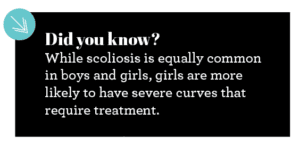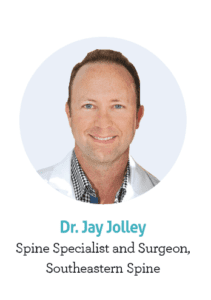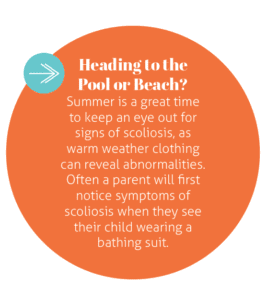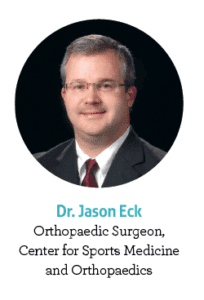Here are six facts every parent should know about scoliosis.
Scoliosis is a condition that causes the spine to curve sideways. While people of all ages can have it, the most common type begins around the age of 10. More than four million new cases of scoliosis are diagnosed in the U.S. each year, the majority of them in children between 10 and 12 years old.
1. Signs and symptoms are subtle.
The most common type of scoliosis is called adolescent idiopathic scoliosis – adolescent, because symptoms first appear during a child’s growth spurt (ages 10 to 15), and idiopathic, because it has no known cause (more on that in #2).
Adolescent idiopathic scoliosis (AIS) can be very easy to overlook because the condition is often painless. If a child wears normal clothing and a parent isn’t on the lookout, it will likely go unrecognized.
Warning signs include a raised or prominent shoulder blade, uneven hips or waist, or a visible curve to the spine resembling a “C” or “S” shape. To examine your child, ask her to bend forward while you look at his or her back. “You want to look for anything asymmetrical,” says Dr. James Osborn, an orthopaedic surgeon with Tennova Spine – Cleveland.
If something looks off, make an appointment with a pediatrician or spine doctor right away. But don’t panic—most curves are mild (measuring less than 20 to 25 degrees) and won’t require treatment.
 “Scoliosis in adolescents rarely requires surgery,” says Dr. Jay Jolley, spine specialist and surgeon with Southeastern Spine. “Most cases only require regular observation from a health care provider.”
“Scoliosis in adolescents rarely requires surgery,” says Dr. Jay Jolley, spine specialist and surgeon with Southeastern Spine. “Most cases only require regular observation from a health care provider.”


2. Scoliosis in adolescents has no known cause.
AIS includes the word idiopathic because its cause is unknown. Despite common misconceptions, scoliosis can’t be caused by playing sports, bad posture, or carrying heavy backpacks.
Children diagnosed with this condition experience little to no discomfort and can still engage in normal physical activity. Doctors recommend that exercise and active play be limited to the child’s level of ability and comfort, but assure parents that sports can neither cause nor increase the effects of scoliosis.
3. It tends to run in families.
According to the Scoliosis Research Society, approximately 30% of all individuals diagnosed with scoliosis have a family history of the disease. This is why researchers and physicians believe it has a genetic component.


That being said, there are also instances where the child is the first in the family to develop the condition. Or, in some cases, a child may suffer from severe scoliosis when she only has a family history of mild scoliosis (or vice versa).
“The severity can vary significantly from generation to generation,” says Dr. Jason Eck, an orthopaedic surgeon with Center for Sports Medicine and Orthopaedics.
4. Early diagnosis is best.
Experts recommend that children be examined before growth spurts for two reasons. First, this is the time that signs and symptoms typically appear. Second, from a physiological standpoint, it’s the most advantageous time to treat AIS.
“Since adolescents are still growing, their spines are more flexible and their bones heal easily,” says Dr. Eck. “We can achieve a much better correction now with bracing and surgery than if you wait.”
The Scoliosis Research Society recommends that boys be examined once around the age of 13 or 14 (grades 8 to 9), and girls twice, at ages 10 and 12 (grades 5 and 7). If your children have a family history of the condition, you should take extra care to have them screened. Even if your child is diagnosed with AIS, many cases require no treatment at all and are simply monitored by your child’s doctor at regular intervals. Only 30% of all cases will require bracing, while an even smaller 10% percent will actually need back surgery to correct the curve.


5. Treatment has high success rates.
As stated earlier, bracing and surgery are only necessary in severe cases. Most curves measure less than 25 degrees and will simply need to be monitored.


In the rare event that surgery is required, the sooner you can have it done, the better. Surgery involves fusing the bones together to stop the curve from progressing.
After surgery, adolescents will need one to two months of recovery before returning to their regular routine. The good news it that this short period can pay off in a lifetime of benefits. Almost all adolescents who undergo surgery for scoliosis go on to lead healthy, happy, and completely normal lives.
6. If your child has it, you are not alone.
AIS affects nearly 1 in 25 adolescents, according to the Scoliosis Research Society. But even though it’s a common condition, parents and children often feel alone and scared after receiving a diagnosis.
A parent may feel guilty for not recognizing scoliosis sooner, or a child may feel self-conscious about the way her back looks. Both can benefit greatly from attending a support group and connecting with others who have the same condition.
“The big thing is not to be afraid of this diagnosis,” says Dr. Osborn. “Scoliosis may feel life-altering, but it can be treated. Early detection is important, but even if you missed it, you shouldn’t feel bad. Treatment outcomes are very good. Children with scoliosis grow up to be adults who enjoy their lives and ride motorcycles and play tennis and softball and have children. It doesn’t have to be a negative experience.”

